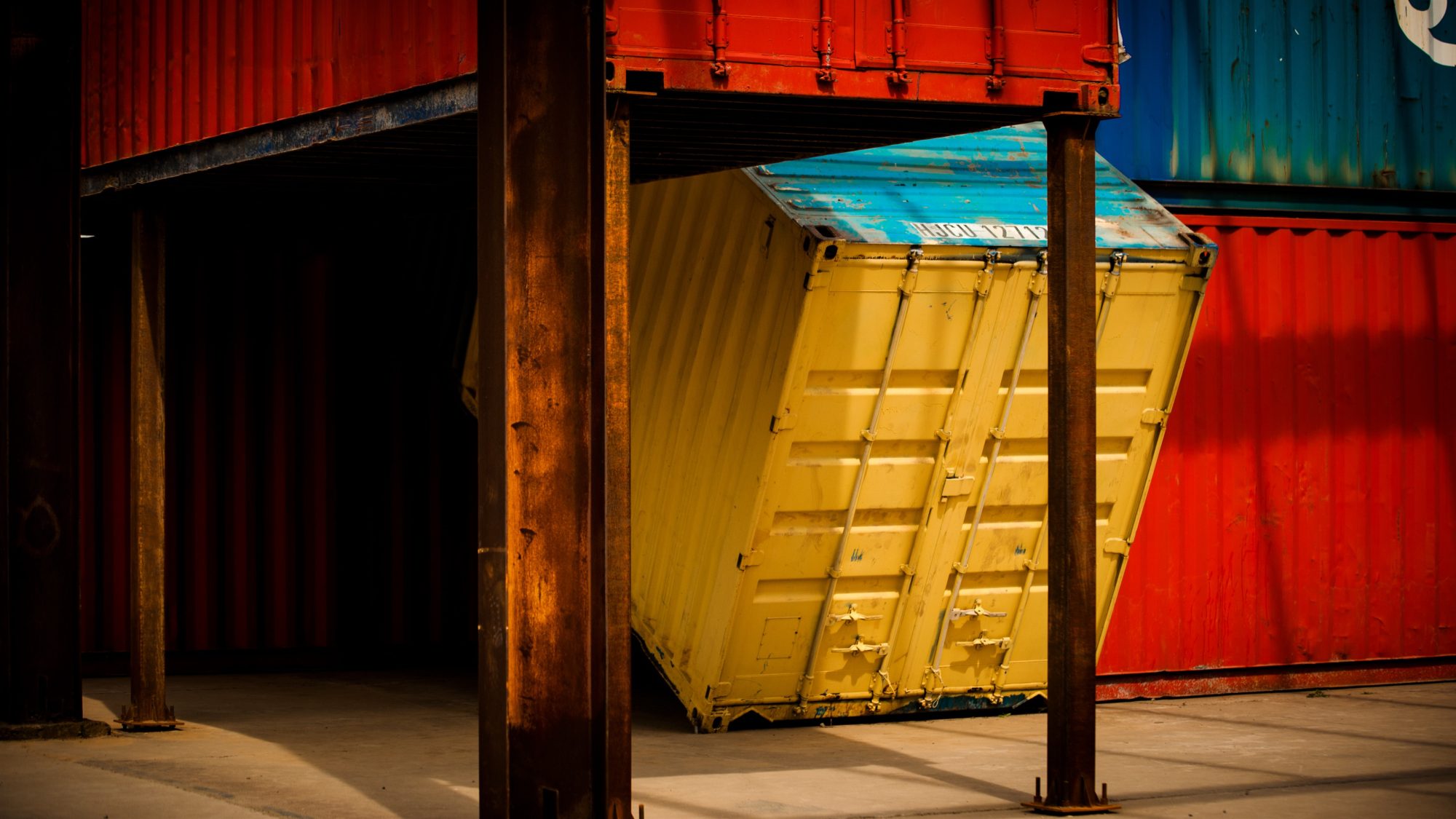Understanding the different container types and dimensions can help you ship your cargo safely.
With so many container types available, it’s important that you choose the right one. In fact, it’s one of the most important business decisions you’ll make. As only the right container can save you money and keep your cargo safe.
Container types and dimensions: Overview
There are several container types in the container market. Each container is manufactured to transport a different type of cargo. For example, temperature-sensitive items like medicines are better suited for reefer containers.
Being part of the shipping business, it’s important that you understand the different container types and their dimensions.
Let’s take a look at the various container types and understand which type of cargo they’re most suitable for.
Standard container types and dimensions
A standard container, in short, DC/GP, is the most common type of container in the market. They are available in two common sizes: 20ft containers and 40ft containers.
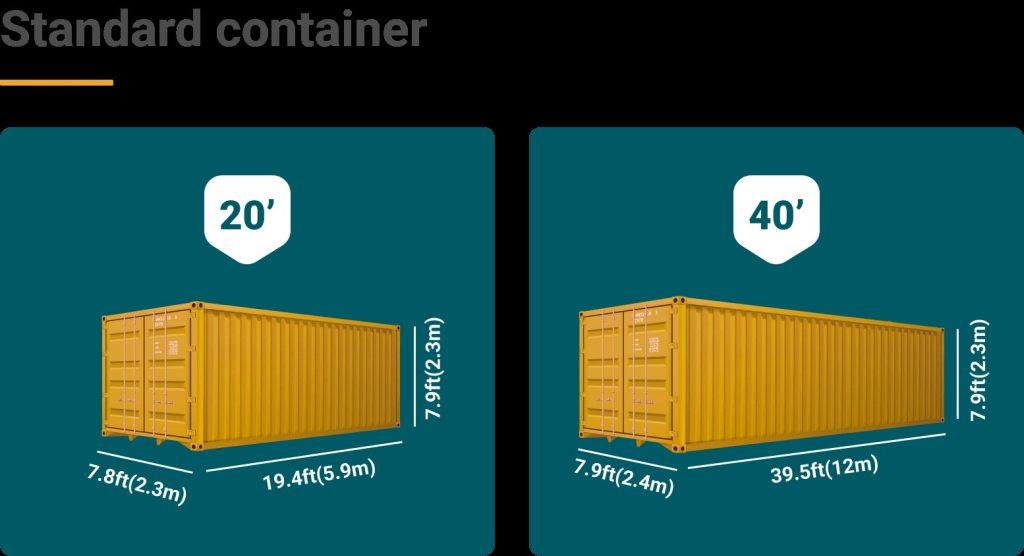
They’re usually made of steel or aluminum. The aluminum containers have a slightly higher payload. In general, these containers are airtight and water-resistant, preventing damage from the outside.
Standard containers can carry most types of dry cargo such as boxes, pallets, sacks, barrels, etc. They can be customized on the inside to carry a specific type of goods. For instance, hangers can be fit inside to carry clothes that could be directly transported to the store.
Since standard containers are basic and easily available, they are not expensive.
Standard container sizes and dimensions
Here are the dimensions of standard 20ft and 40ft containers.
| Measurements | 20ft | 40ft |
| Internal length | 5.9m / 19.4ft | 12.03m / 39.5ft |
| Internal width | 2.35m / 7.8ft | 2.4m / 7.9ft |
| Internal height | 2.39m / 7.9ft | 2.39m / 7.9ft |
| Tare weight | 2,300kg / 5,071.5 lbs | 3,750kg / 8,268.8 lbs |
| Payload capacity | 25,000 kg / 55,126.9 lbs | 27,600kg / 61,200 lbs |
| Cubic capacity | 33.2 m3 / 1,172 cu ft | 67.7 m3 / 2,389 cu ft |
High cube container
High cubes, in short, HC/HDC/HQ, are actually similar in structure to standard containers. The length and width remain the same but the height increases by 1 foot. This enables them to meet more cargo demands.
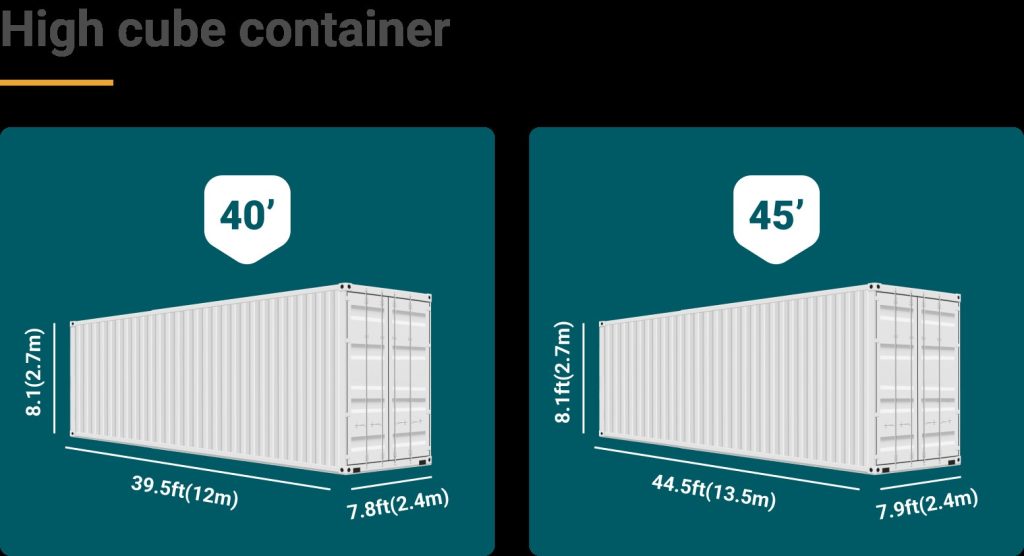
High cube containers also come in two sizes: 40ft HC and 45ft HC. Since these containers have additional height, they provide more storage value at their price point. They’re suitable if you need more storage for your cargo that a 20ft or 40ft container can’t fulfill.
High cube container sizes and dimensions
Here are the dimensions of 40ft HC and 45ft HC containers.
| Measurements | 40ft HC | 45ft HC |
| Internal length | 12.03m/39.5ft | 13.55m/44.5ft |
| Internal width | 2.35m / 7.8ft | 2.35m / 7.8ft |
| Internal height | 2.70m / 8.10ft | 2.70m / 8.10ft |
| Tare weight | 3,900kg / 8,598 lbs | 4,800kg / 10,552 lbs |
| Payload capacity | 28,600 kg / 63,052 lbs | 27,700kg / 61,067 lbs |
| Cubic capacity | 76.3 m3 / 2,694.5 cu ft | 86 m3 / 3,037 cu ft |
Now that you have an overview of standard containers, let’s take a look at specialized containers. These containers are useful if you have specialized cargo. Read on to find out which container is best for your shipping needs.
Special container types and dimensions
A special container is used for specific needs that can’t be covered by a standard container. Many things can be changed in a special container, such as:
- A different position of the door(s)
- Changes in the height and width of the container itself
- Technological modifications of containers
Below is a list of special container types and dimensions that you should be aware of.
Reefer container
Reefer containers are container-sized refrigerators used to move temperature-sensitive goods. The flooring of the reefer container has a T-shaped decking that sends chilled air into the container. This makes sure there is consistent airflow among the goods. They can maintain any temperature between -30°C and +30°C.
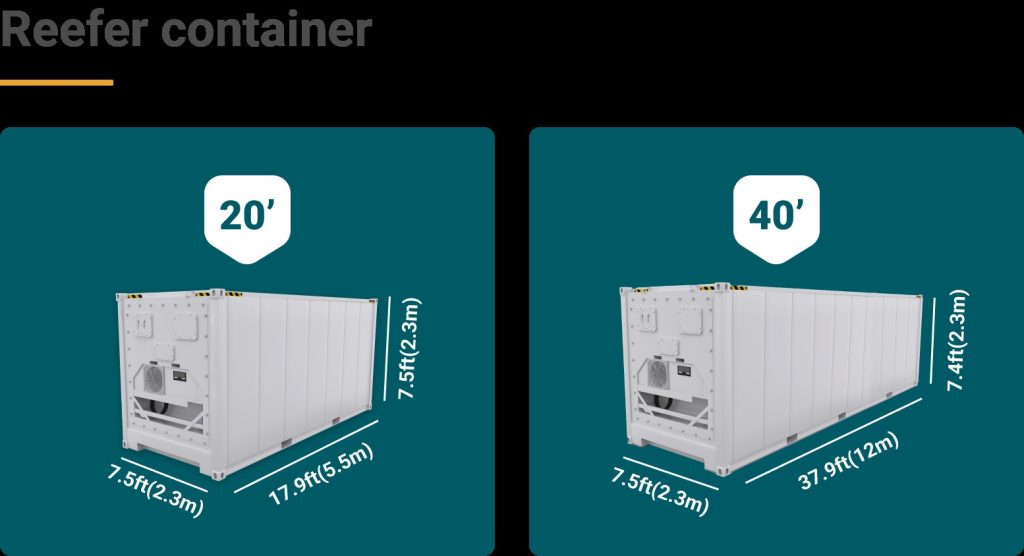
Reefers carry temperature-sensitive items such as fruits, vegetables, ice cream, drugs, or meat. Each item has a different temperature requirement and it needs to be maintained to protect its freshness. The reefer container can be sectioned to cool and freeze at the same time. It is powered by a generator that provides electricity. When they’re on the road being transported by trucks, the containers are powered by fuel. The reefer container is expensive considering the power and maintenance requirements
Reefer container sizes and dimensions
Here are the dimensions of the reefer containers. They’re available in three sizes, 20ft, 40ft, and 40ft HC.
| Measurements | 20ft | 40ft | 40ft HC |
| Internal length | 5.44m / 17.9ft | 11.56m / 37.9ft | 11.56 m/ 37.9ft |
| Internal width | 2.29m / 7.5ft | 2.28m / 7.5ft | 2.29m / 7.5ft |
| Internal height | 2.27m / 7.5ft | 2.25m / 7.4ft | 2.55m / 8.36ft |
| Tare weight | 3,080kg / 6,791.4 lbs | 4,800kg / 10,584 lbs | 4,480kg / 9,880lbs |
| Payload capacity | 27,400 kg / 60,471 lbs | 27,700 kg / 61,078 lbs | 29,520kg / 65,080 lbs |
| Cubic capacity | 28.3m3 / 999 cu ft | 59.3 m3 / 2,093.3 cu ft | 67.3 m3 / 2,380 cu ft |
Double door container
Double-door containers are built to have doors that swing open outside on both ends. Both sets of doors are built with the same specifications. It is the most convenient option for loading and unloading a container, as you can load and unload goods quickly from either end of the container, as required. For instance, if you load a car, you can just drive it through a double-door container. You don’t need to reverse it while unloading.
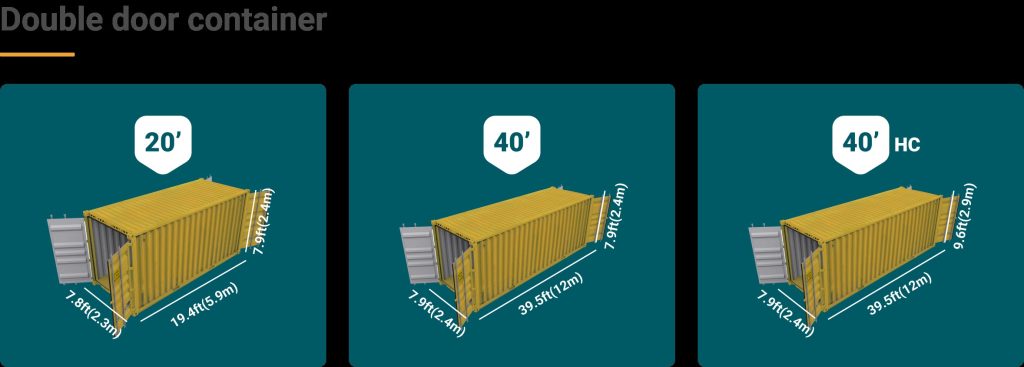
Double-door container sizes and dimensions
Double-door containers have three sizes, 20ft, 40ft, and 40ft HC. Here are the dimensions.
| Measurements | 20ft | 40ft | 40ft HC |
| Internal length | 5.9m / 19.4ft | 12.03m / 39.5ft | 12.03m / 39.5ft |
| Internal width | 2.35m / 7.8ft | 2.4m / 7.9ft | 2.34m / 7.8ft |
| Internal height | 2.39m / 7.9ft | 2.39m / 7.9ft | 2.69m / 8.9ft |
| Tare weight | 2,300kg / 5,071.5 lbs | 3,750kg / 8,268.8 lbs | 5,200kg / 11,470lbs |
| Payload capacity | 25,000 kg / 55,126.9 lbs | 27,600kg / 61,200 lbs | 28,600kg / 63,052 lbs |
| Cubic capacity | 33.2 m3 / 1,172 cu ft | 67.7 m3 / 2,389 cu ft | 76.3m3 / 2,694 cu ft |
Open-top container
Open-top containers, as the name suggests, have an open top. The roof of the container is covered with tarpaulin sheets instead of a solid roof. This way, it can be covered or left open according to convenience. The container is made of steel with wooden flooring and the door heads can be swung open for easy loading and unloading.
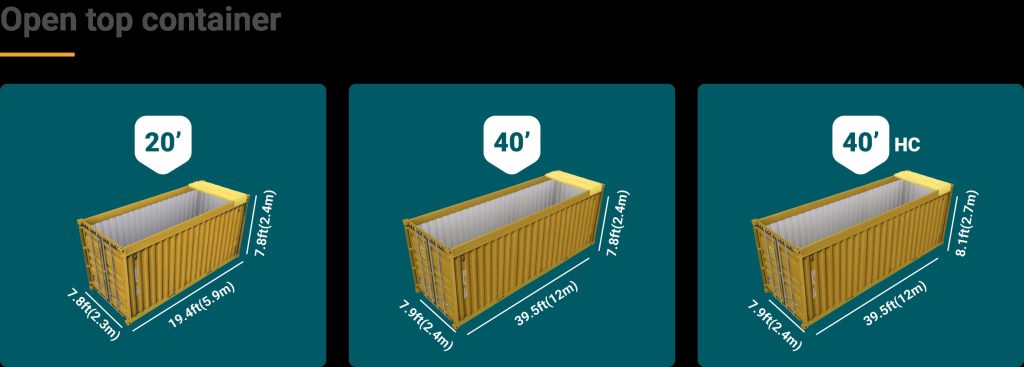
Open-top containers are used when your cargo is too large to fit in a regular shipping container. For instance, machinery or heavy materials can’t be stowed sideways but are arranged from the top through heavy-lifting cranes. These containers have larger capacities than the normal ones as the roof is open. It has lashing rings that keep the cargo stable and has the capacity to load 1000 kgs.
Open top container sizes and dimensions
Open-top containers have three sizes: 20ft, 40ft, and 40ft HC. Take a look at the table below for the dimensions of each.
| Measurements | 20ft | 40ft | 40ft HC |
| Internal length | 5.89m / 19.4ft | 12.03m / 39.5ft | 12.03m / 39.5ft |
| Internal width | 2.35m / 7.8ft | 2.4m / 7.9ft | 2.35m / 7.8ft |
| Internal height | 2.35m / 7.8ft | 2.34m / 7.8ft | 2.70m / 8.10ft |
| Tare weight | 2,260kg / 5,982 lbs | 3,980kg / 8,774 lbs | 4,250kg / 9,370 lbs |
| Payload capacity | 28,220 kg / 62,214 lbs | 26,500kg / 58,422 lbs | 28,250kg / 62,281 lbs |
| Cubic capacity | 32.7 m3 / 1,155 cu ft | 66.7 m3 / 2,356 cu ft | 74.9 m3 / 2,645 cu ft |
Pallet wide container
A pallet-wide container is a special container designed to accommodate a larger number of Euro pallets, commonly used in Europe. The pallets are usually the size of 1200 x 800 x 144. A standard 20-foot container can carry 11 of them, while a pallet-wide 20-foot container can carry 15 pallets. This is possible because the containers are approximately 5m wider on the inside than the standard ones.
Just like standard containers, pallet-wide containers are also manufactured from steel but their floor is made with wooden planks for higher durability and friction coefficient.
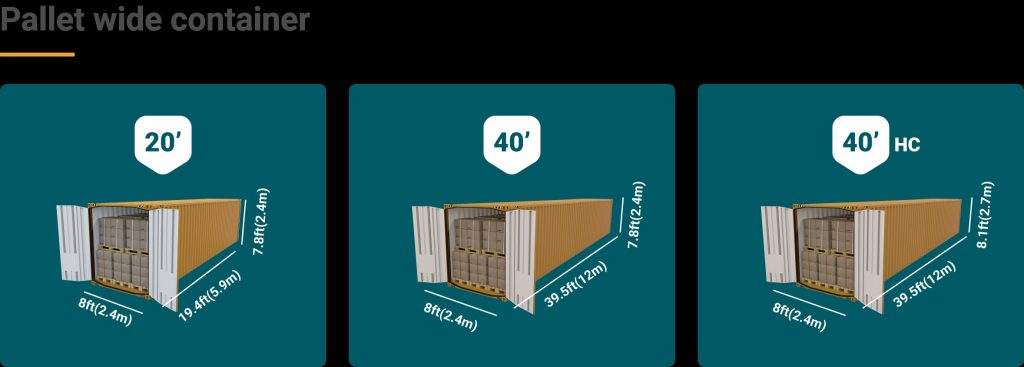
Pallet-wide container sizes and dimensions
Pallet-wide containers are available in three sizes. These are 20ft, 40ft, and 40ft HC. The table below gives the dimensions of each size.
| Measurements | 20ft | 40ft | 40ft HC |
| Internal length | 5.89m / 19.32ft | 12.03m / 39.46ft | 13.55m / 44.5ft |
| Internal width | 2.44m / 8ft | 2.44m / 8ft | 2.41m / 7.9 ft |
| Internal height | 2.39m / 7.84ft | 2.38m / 7.80ft | 2.69m / 8.85ft |
| Tare weight | 2,400kg / 5,291.09 lbs | 3,800kg / 8,377.56 lbs | 4,280kg / 9,435.7lbs |
| Payload capacity | 28,080 kg / 61,905.80 lbs | 26,680kg / 58,819.33 lbs | 29,720kg / 65,521.38 lbs |
| Cubic capacity | 34.34 m3 / 1,213 cu ft | 69.86 m3 / 2,467.12 cu ft | 86.2m3 / 3,044.12 cu ft |
Flat rack container
Flat rack containers only have sides on the short ends of the container. They are used for heavy loads and cargo that need loading from the top or sides, such as pipes, machinery, or even buses.
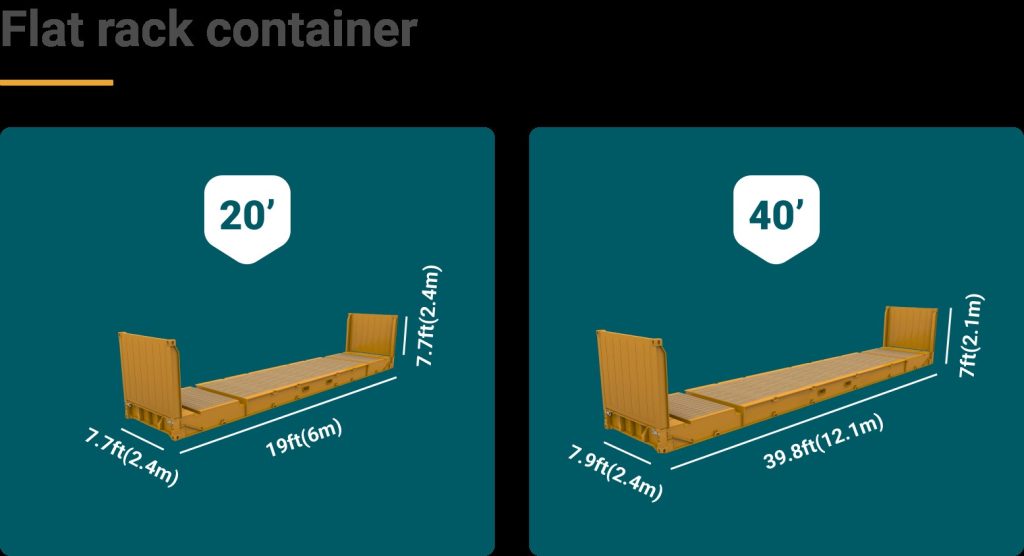
The numerous lashing rings allow the load to be secured safely and by legal regulations. For example, crates exceeding the size of a closed container can be loaded. It’s even possible to attach stanchions. Thus, creating a lateral boundary without having to forego the other advantages of a flat rack container.
Flat rack container sizes and dimensions
The table below shows the dimensions of flat rack containers in different sizes.
| Measurements | 20ft | 40ft |
| Internal length | 5.94m / 19ft | 12.13m / 39.8ft |
| Internal width | 2.35m / 7.7ft | 2.40m / 7.9ft |
| Internal height | 2.35m / 7.7ft | 2.14m / 7ft |
| Tare weight | 2,360kg / 5203.8 lbs | 5,000kg / 11,025 lbs |
| Payload capacity | 30,140 kg / 66,458.7 lbs | 40,000kg / 88,200 lbs |
| Cubic capacity | 32.7 m3 / 1,154.3 cu ft | 62.2 m3 / 2,195.7 cu ft |
Flat rack containers are suitable for shipping specialized cargo. However, it’s difficult to get your hands on flat rack containers in your desired locations through traditional sourcing channels.
Side door container
A side door container, also known as an open side container, has extra doors that open on the long side of the container. The side doors make it extremely convenient to load cargo that is bulky and can’t fit through the end doors. More workers can work simultaneously while loading or unloading cargo, as the side doors give full access to the container.
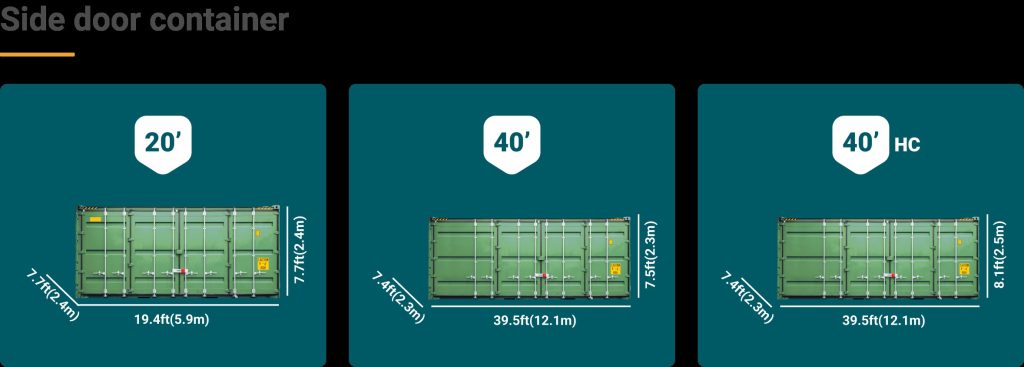
Side door container sizes and dimensions
Side door containers are available in three sizes. Here are the dimensions of each.
| Measurements | 20ft | 40ft | 40ft HC |
| Internal length | 5.9m / 19.4ft | 12.03m / 39.5ft | 12.03 m / 39.5 ft |
| Internal width | 2.35m / 7.7ft | 2.28m / 7.4ft | 2.34 m / 7.8 ft |
| Internal height | 2.34m / 7.7ft | 2.29m / 7.5ft | 2.69 m / 8.9 ft |
| Tare weight | 2,700 kg / 5,950 lbs | 4,700 kg / 10,362 lbs | 5,200 kg / 11,470 lbs |
| Payload capacity | 27,780 kg / 61,244 lbs | 27,300 kg / 60,180 lbs | 28,600 kg / 63,052 lbs |
| Cubic capacity | 33.0 m3 / 1,165 cu ft | 64 m3 / 2,2306 cu ft | 76.3 m3 / 2,694 ft3 |
Hard top container
Hard top containers are very similar to open containers with the difference being a detachable steel roof instead of a tarpaulin sheet. The roof of a hard top container has points through which a forklift can lift the roof. As seen with the previous containers, this design allows for easy loading/unloading of specific types of cargo.
Hard top containers are especially functional for heavy goods and heightened cargo — which needs to be loaded through the roof or doors using a forklift, crane, or crab. Cargo transported using hard top containers include marble, glass sheets, raw materials (like coal), large machinery, etc.
Hard top container sizes and dimensions
Take a look at the table below to get the dimensions of hard-top containers.
| Measurements | 20ft | 40ft | 40ft HC |
| Internal length | 5.89m / 19.4ft | 12.03m / 39.5ft | 12.03m / 39.5ft |
| Internal width | 2.35m / 7.8ft | 2.4m / 7.9ft | 2.4m / 7.9ft |
| Internal height | 2.35m / 7.8ft | 2.34m / 7.8ft | 2.69 m / 8.9 ft |
| Tare weight | 2,260kg / 5,982 lbs | 3,980kg / 8,774 lbs | 5,200 kg / 11,470 lbs |
| Payload capacity | 28,220 kg / 62,214 lbs | 26,500kg / 58,422 lbs | 28,600 kg / 63,052 lbs |
| Cubic capacity | 32.7 m3 / 1,155 cu ft | 66.7 m3 / 2,356 cu ft | 76.3 m3 / 2,694 ft3 |
Tank container
Tank containers are cylindrical in shape. These containers, also known as tankers, are made of strong steel and anti-corrosive materials. This ensures that the containers can sustain the transport and protect the liquid material they carry.
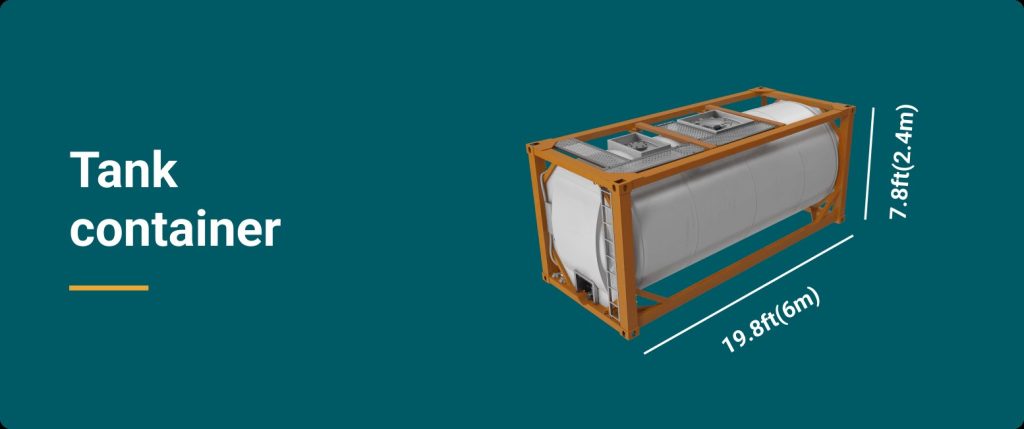
In most cases, tank containers are used to transport dangerous goods, gasses, and liquids. Each tank container goes through a thorough inspection before it’s allowed to carry goods.
Tank container sizes and dimensions
Here are the dimensions of a tank container.
| Measure | 20FT |
| Inside length | 6.058 m |
| Inside width | 2.438 m |
| Door width | 0 m |
| Door height | 0 m |
| Capacity | 21,000 l |
| Tare weight | 26290 kg |
Insulated container
Insulated containers keep the same temperature inside the container, regardless of the temperatures outside its four walls. They’re suitable for transporting temperature-sensitive goods.
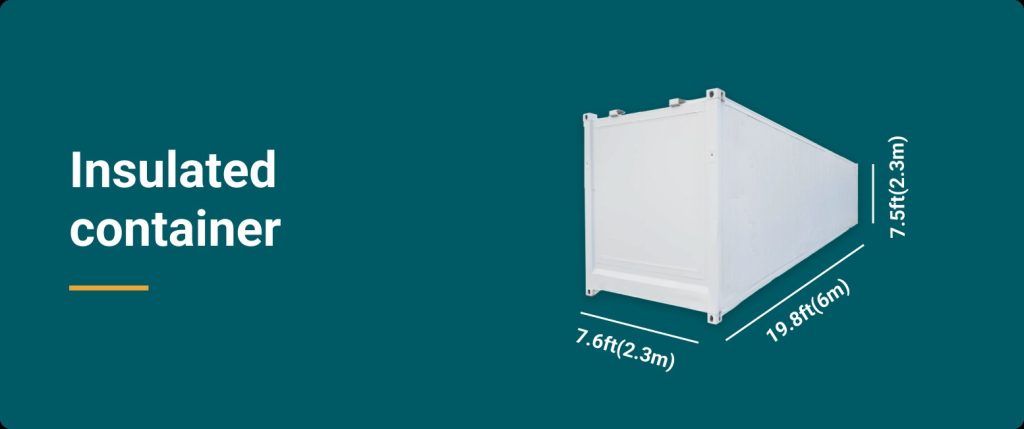
Insulated containers often have a double wall. It’s vacuumed so it prevents heat and cold transfer between the outside of the box and the inside. Moreover, the interior is fully sealed to avoid condensation and moisture.
Insulated container sizes and dimensions
Take a look at the table below if you want to know the exact dimensions of an insulated container.
| Measurements | 20ft | 40ft |
| Internal length | 5.75m/18.10ft | 1.561m/37.11ft |
| Internal width | 2.26m/5.7ft | 2.28 m/7.6ft |
| Internal height | 2.11m/6.11ft | 2.249m/7.5 ft |
| Tare weight | 2650 kgs/ 5840lbs | 4800 kgs/ 10580lbs |
| Payload capacity | 21350 kgs/ 47070lbs | 27700 kgs/ 61070lbs |
| Cubic capacity | 970cu ft | 2090cu ft |
Half-height container
Talking about the different container types here’s a shout-out to a very special box, the half-height. Half-height containers are ideal for moving heavy goods with low-volume cargo. They are used to transport pipes, tools, chains, hooks, anchors, and sometimes even vehicles. Locally, these containers are also used to transport items such as coal, sand, and gravel. If you are transporting over-height goods, half-height containers can be an ideal choice.
Half-height containers follow the DNV (Det Norske Veritas) standards. A DNV-approved half-height container is equipped with slings, shackles, and multiple internal lashing points. There are also net securing points, cargo restraining nets, anti-slip surfaces, and forklift points for safety purposes.
A half-height container also comes as an open-top container for easy loading and unloading of cargo. You also have the option to customize it with removable side or swinging doors. You can also choose a range of sizes that suits your need.
Half-height container size and dimensions
Here are the dimensions of a 20ft half-height container
| Measure | 20ft |
| Internal length | 19.3ft (5.88m) |
| Internal width | 7.3ft (2.22m) |
| Internal height | 3.1ft (0.94m) |
| Tare weight | 2,378 kg/ 5,240 lbs |
| Payload capacity | 10,000 kg / 22,050 lbs |
| Cubic capacity | 12.25 m³/ 432.6 cu ft |
After discussing so many containers, you might be confused between similar container types. Read on to know the differences between them.
Differences in different types of shipping container
As you have seen, each shipping container type is designed to ship a different type of cargo. It’s important that you understand the container types if you want your cargo to be safe. However, with so many similar container types, it’s natural to get confused.
Here are the differences between a few container types.
Flat rack container vs open-top container
Both flat rack and open-top containers are used to ship specialized cargo. The main difference between the two is that the flat rack only has walls on the short end of the container. Whereas, an open-top container doesn’t have a roof.
If you have specialized cargo like machines or equipment that can’t fit inside an open top, you should choose a flat rack.
However, if your cargo can be put inside an open top using heavy-lifting cranes and fits inside the container, you should go for an open-top container.
Insulated container vs reefer container
Insulated and reefer containers are both used to ship cargo that’s temperature sensitive. However, there’s a minute difference in the cooling system of both these containers. Take a look at the table below to know the differences.
| Reefer container | Insulated container |
| Provides precise temperature control inside the container. | Only maintains the initial temperature |
| Used for climate-controlled storage | Used for maintaining the initial temperature |
| Keep goods cold, frozen, or at a specific temperature during long-distance shipping | Protects the interior from exterior conditions and often used in the retail market |
By now you must have chosen the right container type for your shipping needs. But where can you find the exact container type in your desired location? Well, that’s where Ozal Darya Shipping Line comes into the picture.
Read on to find out how you can buy & sell containers on our trading platform.
Buy or sell different container types and sizes on Ozal Darya
Getting the exact container type at your desired location is quite tricky if you’re using traditional sourcing channels. Even if you do find the container you’re looking for, there’s no guarantee that you’re paying the right price due to the lack of transparency in the industry.
However, if you’re a member of Ozal Darya, you can easily trade containers with 100% market transparency. We’ve created a neutral online trading platform that works exactly like an online store.
You can browse through various container types across conditions, locations, and prices. When you’ve set your eyes on a container, or a bunch of them, you can reach out to the seller directly and negotiate a price.
We have over 10,000+ containers at 2500+ locations. So, there’s a higher chance you’ll get your hands on your desired container type. Moreover, we don’t charge any commission on container sales.
Container types and dimensions: Common FAQs
What are the different types of containers?
There are many different container types. Standard container types include a 20ft dry container, a 40ft dry container, and high cube containers (with extra height). Specialized container types include reefer, pallet-wide, tank, open-top containers, etc.
Which container types are the most common?
Some of the most common container types are 20ft DC, 40ft DC and 40ft DC high cube containers. They are standard container types used for shipping dry cargo.
Which container is used for shipping temperature-sensitive goods?
Reefer containers or insulated containers are used for shipping temperature-sensitive goods. If your cargo is to be shipped at a specific temperature, then a reefer container is your ideal choice. However, if your cargo can be shipped by maintaining the initial temperature of the container, you should use an insulated container.

